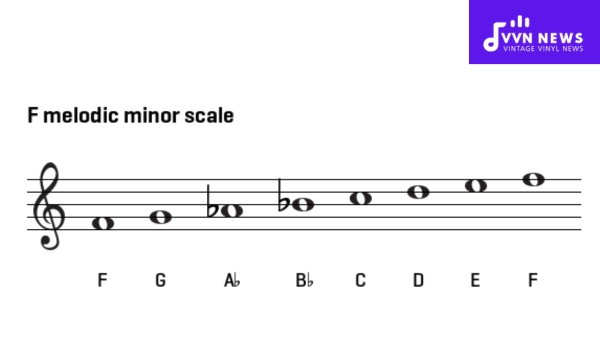For many musical enthusiasts, the world of scales can be a vast and thrilling adventure. One such marvel nestled in this world is the F melodic minor scale. This sense-pleasing scale has an intricate structure that unlocks a treasure trove of melodies in various genres.
If you’ve always been curious about venturing into the realm of melodic minors, this blog post is your access pass.
The beauty encapsulated in the F melodic minor scale isn’t just about its melodious flavor; it’s also about its fascinating ability to add depth to any composition.
Through this blog post, I shall take you on an enlightening journey to understand the secrets behind mastering this intriguing minor scale, along with its practical applications and relevance in modern music.
Breakdown of Intervals in F Melodic Minor Scale
Counting the intervals in the F Melodic Minor scale set the foundation of its unique structure.
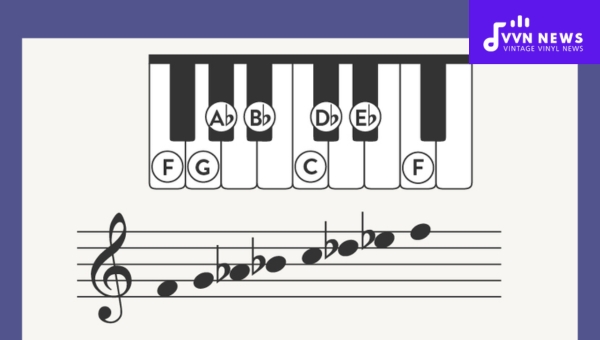
On ascending, from F to G, is a whole tone (2 frets); G to Ab is a semi-tone; Ab to Bb, Bb to C, C to D, and D to E are all whole tones.
In descending order though, there’s a shift: E to Eb and Eb to Db have a semi-tone gap; Db to C, C to Bb, and Bb to A have whole tones while lastly A to G and G to F feature semi-tones.
Also Read: Harmony In Music [Enhance Your Compositions With These Tips]
Melodic minor scale formula explained
The melodic minor scale formula is a standing invitation to a colorful world of harmonious sounds. This essential component of music is not as complex as it appears.
Let’s look at the theoretical structure: The ascending scale follows the formula, Tone – Semitone – Tone – Tone – Tone – Tone – Semitone (T-S-T-T-T-T-S).
On the flip side, the descending sequence changes to mirror that of a natural minor scale, ruled by this pattern: Tone – Tone – Semitone – Tone – Tone – Semitone – Tone (T-T-S-T-T-S-T).
This elegant dance of tones and semitones gives the melodic minor scale its characteristic tonal colors.
It’s worth noting that ‘T’ denotes whole steps (two-fret jumps on guitar or two-key leaps on keyboard), while ‘S’ signifies half steps (one-fret or one-key).
What makes up the ascending F melodic minor?
If you’re diving into the ascending F melodic minor scale, you’ll discover an intriguingly structured pattern.
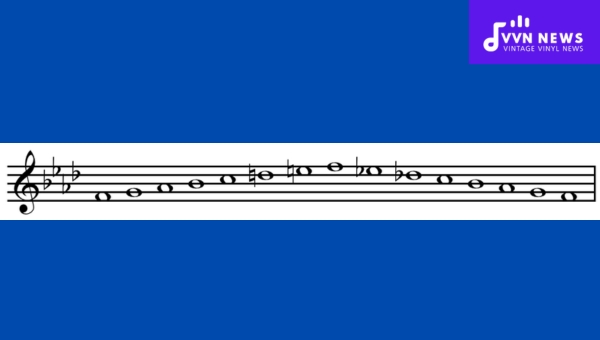
This scale consists of eight degrees, each with its unique role and name. The framework follows this pattern –
- 1st degree – The root or tonic – F
- 2nd degree – Supertonic – G
- 3rd degree – Mediant – Ab
- 4th degree – Subdominant – Bb
- 5th degree – Dominant – C
- 6th degree – Submediant – D
- 7th degree – Leading note-E
- 8th Degree (Concluding) – The root or tonic travels back to the beginning-F.
Each of these notes/degrees contributes specifically to forming the beautiful F melodic minor scale in its ascending form.
A deeper exploration reveals these notes’ potential to create memorable melodies and express emotions in unforgettable ways.
Components of descending F melodic minor
There’s no denying the uniqueness of the F melodic minor scale, especially when it comes to its ‘split personality’. Its descent provides a slightly different formula than its ascent. I invite you to meticulously probe into its structure now.
Sequence of Degrees in Descending Scale:
- 1st Degree: Begins at the root/tonic – ‘F’
- 7th Degree: Drops down to the leading note – ‘Eb’
- 6th Degree: Further descends to the submediant – ‘Db’
- 5th Degree: Dips to the Dominant – ‘C’
- 4th Degree: Moves down to the Subdominant – ‘Bb’
- 3rd Degree: Further falls to the Mediant – ‘Ab’
- 2nd Degree: Heads towards the Supertonic – ‘G’
- 1st degree: Ends back at the root/tonic – ‘F’
This downward ride or rather ‘slide’ of the F melodic minor scale comprises only natural minor notes.
As you mindfully articulate each note, you will feel an air of relaxation; it’s like walking down an easy slope after an exhilarating climb.
Also Read: Phrygian Mode [Adding Exotic Flair To Your Musical Compositions]
F Melodic Minor Instructions On Various Instruments
You may be curious to know how you can apply the F melodic minor scale to various instruments.
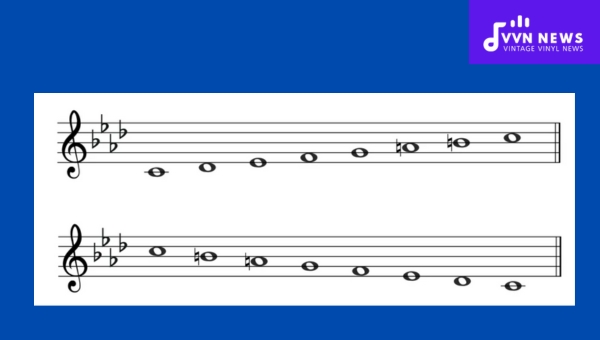
It’s true that each instrument has its unique arrangement, but with the essential formula and practice, you can create a lovely swell of melodies using the F melodic minor scale.
Here are some practical instructions on how to play this enchanting scale across different instruments.
Piano
The melodic structure of the F melodic minor scale makes it a pleasure on instruments like piano.
The notes for this scale on a piano are F – G – Ab – Bb – C – D – E (ascending) and E – Eb – Db- C – Bb – Ab – G – F (descending).
To execute it effectively;
- Start by locating the “F” note on your keyboard.
- To ascend, play all white keys from “F” to “E,” except when playing “Ab.”
- Understand that descending requires the usage of 3 flat keys; Eb, Db, and Ab, The remaining will be white keys in descending order until you return to “F.”
Guitar
On a guitar, playing the F melodic minor demands familiarity with fret patterns. Especially when you consider that ascending and descending have different notes.
For ascending:
- Begin on the 1st fret (F note) of the low E string.
- Move two frets up to reach G.
- On the same string move one fret up for Ab.
- Now switch over to A string and start from the first fret for Bb.
- Thereafter continue in sequence, moving on to the next strings wherever necessary.
Descending is similar except we begin from a high e string with E note and use flats where needed.
Violin
A melodious instrument like the violin embraces melodic minors endearingly:
- To begin playing this divine scale on your violin, start with the first finger on the “F” note on the ‘D’ string for F, G, and Ab.
- Then use open A for A#, followed by a continuing sequence of notes with B, C, D, and E on the ‘A’ string.
The positions of fingers slightly vary while coming down with reference to flats in melodic minor’s descending version.
Incorporating the F melodic minor scale across an array of instruments can certainly enrich your repertoire.
Just remember to follow the formula, according to the specific needs of your instrument and practice!
Practice will solidify your newfound knowledge and embolden you to experiment further.
Also Read: A Sharp Minor Pentatonic Scale [Unique Harmonic Possibilities]
Key Signature Details for F Melodic Minor
Delving into the key signature of the F melodic minor scale, one finds its unique shade painted with 4 flats.
Specifically denoted as Bb, Eb, Ab, and Db. These flats succinctly bring out the distinctive essence of this minor scale.
- Natural Minor Scale – F, G, Ab, Bb, C, Db, Eb
- Melodic Minor Scale (Ascending) – F, G, Ab, Bb, C, D, E
- Melodic Minor Scale (Descending) – F, Eb, Db, C,Bb,AbG*
One must meticulously adhere to these flats to deliver an accurate rendition of this particular scale and explore its hidden melodies.
The consistent precision in your playing will eventually enhance the overall tonal quality.
Grasping the F Melodic Minor Across Different Clefs
The interaction between musical scales and clefs is like a well-choreographed dance number; perfect harmony and cohesive movement.
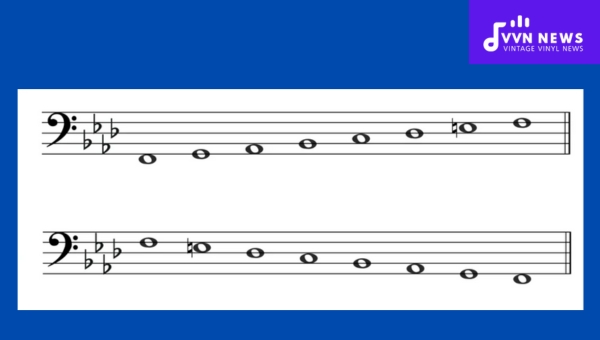
The F Melodic Minor Scale, being one of these captivating scales, is essentially represented across the three most common clefs: Treble, Bass, and Alto.
Treble Clef
The F Melodic Minor Scale begins with F on the first staff line in the treble clef. Ascending from there, it hits G on the second line, before flirting with Ab (A Flat) on the second space.
It then rises to Bb(you might also know it as A#) on the third line then rises again to touch C on the third space. Swiftly moving to D landing perfectly on fourth line , it finally proceeds to E – F.
Now comes its descent; where unlike its ascent, it transforms sevens and sixths degree into natural notes; thus descending via E – D – C – Bb – Ab – G – F.
Bass Clef
The charm of the F Melodic Minor Scale remains equally riveting in its expression through bass clef.
Here, it starts its journey from F below middle C(C4). It progresses smoothly via G below middle C and further via Ab just above middle C , after which comes Bb above middle C followed by C5 .
Scaling upwards, next comes D5 , concluding with E5 – F5 . On its way down though, pretty much like in treble clef, seventh and sixth scale degrees occur naturally as E5 and D5.
Alto Clef
Primarily utilized for viola music sheets but not restricted to just that , here F melodic minor scale begins on the middle line for F; second space for G; third line for Ab; third space for Bb; fourth line for C; fifth line for D and upper space (Above the staff) signified via a ledger line, reaching F.
In reverse order, it reverts back from upper-space E , to fifth-line D .
So, whether you’re hold a guitar or seated at a piano or even with a viola tucked under your chin, the magic of the F Melodic Minor Scale can pretty much seep its way through any clef, entrancing both the musician and listener alike.
Also Read: Transposition Chart [A Lifesaver For All Musicians]
Chord Composition in F Melodic Minor
Chord building in the F melodic minor scale can give your music a rich and interesting sound.
To construct chords, one must start with the root note (F), and add thirds above it using only the tones of the scale.
Here’s a simple list of these chords:
- FmMaj7 – F, A♭, C, E
- Gm7 – G, B♭, D, F
- A♭Maj7#5 – A♭, C, E, G
- B♭7 – B♭, D, F, A♭
- C7 – C,E,G,B♭
- Dm7b5 – D,F,A♭,C
- E diminished fully diminished 7th: E,G,B♭D.
Experimenting with these chords can open up new realms in your musical journey while playing or composing within the F melodic minor genre.
The Jazz Form of F Melodic Minor Scale
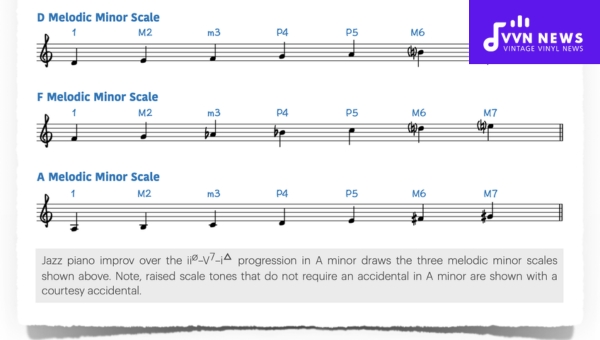
A favored tool among jazz musicians, the F melodic minor scale offers a unique harmonic flexibility.
When several chords are borrowed from it, they create a beautiful jazz minor or even a minor-major 7th chord. Here’s how it works:
The structure of the jazz form is straightforward: F – G – Ab – Bb – C – D – E.
Unlike the classical variation which ascends and descends differently (“scale of twofold use”), the jazz form remains unchanged in both ascent and descent.
Its rich harmonic possibilities contribute to many distinctive jazz solos and improvisations.
Its usage significantly elevates bebop, hard bop and even forms of fusion.
This deviation from traditional melodic minors is what truly sets it apart in the magical universe of scales.
In essence, exploring this scale can redefine your approach towards creating enviable solos or improvisations—in essence, your music journey!
FAQs
What is a Melodic Minor Scale?
A melodic minor scale is a seven-note musical scale that typically ascends with half and whole steps that differ from its descending variation.
How does F Melodic Minor Ascending scale look like?
The ascending version of the F Melodic minor consists of the notes: F, G, Ab, Bb, C, D, E.
What about the sequence for the F Melodic Minor Descending scale?
In descent, the F Melodic Minor reverts to a natural minor sequence: F,Eb,D,C,Bb,A,G,F.
Which genres prominently feature the usage of F Melodic minor?
The F melodic minor scale is widely used in jazz improvisation and classical music compositions.
Why bother learning different scales like F melodic minor?
Learning different scales like the F melodic minor enhances your execution of melodies and harmonies in various musical pieces.
Also Read: How To Transpose Treble To Bass Clef [Music Guide]
Conclusion
The F melodic minor scale is indeed a captivating universe of rhythm that every music enthusiast should explore. It proffers a beautiful cornucopia of tunes with an extraordinary blend of emotional depth and harmonic richness.
Practice it diligently on your chosen instrument and soon you’ll appreciate its nuanced structure. The ability to master this scale holds the potential to elevate your musical journey, stirring up compelling melodies that engage listeners deeply.
In sum, the F melodic minor scale represents vibrance and versatility in the ever-enchanting world of music.
